I am pretty new to the iOS SDK so I am trying hard to learn how to do things properly, so please feel free to point out any flaws in the way I am doing things aside from my question. Also I using the Xamarin framework but I can more or less translate Obj-C into what I am doing so either answer is fine.
I am creating a custom cell that is very similar to the UITableViewCellStyleSubtitle. Infact the only difference is that I want a slightly larger cell size in terms of height and a Calendar icon on the right side of the cell. To do the calendar icon I have 2 UILabels that act as the top and bottom half of the calendar. This way I can put text in them dynamically for month and date:
public pendingMessagesCell (NSString cellId) : base(UITableViewCellStyle.Subtitle, cellId)
{
_calendarBottom = new UILabel () {
TextColor = UIColor.White,
BackgroundColor = UIColor.Gray,
TextAlignment = UITextAlignment.Center
};
_calendarTop = new UILabel () {
TextColor = UIColor.White,
BackgroundColor = UIColor.DarkGray,
TextAlignment = UITextAlignment.Center
};
Following the guide in this stack overflow question I use EstimatedRowHeigh and UITableView.AutomaticDimension in my TableViewController :
public class pendingMessageTableViewController : UITableViewController
{
/// <summary>
/// Parent Controller.
/// </summary>
private pendingViewController _controller;
/// <summary>
/// Messages pending
/// </summary>
private IList<Message> pendingMessages;
/// <summary>
/// Initializes a new instance of the <see cref="SaltAndPepper.ios.pendingMessageTableViewController"/> class.
/// </summary>
public pendingMessageTableViewController (UITableViewStyle style) : base(style)
{
}
public override void ViewDidLoad ()
{
base.ViewDidLoad ();
pendingMessages = new List<Message> ();
pendingMessages = MessageManager.GetMessages ();
var source = new pendingTableMessageViewSource (pendingMessages);
TableView.Source = source;
TableView.RowHeight = UITableView.AutomaticDimension;
TableView.EstimatedRowHeight = 66;
TableView.TableFooterView = new UIView(CoreGraphics.CGRect.Empty);
this.AutomaticallyAdjustsScrollViewInsets = false;
}
Then in my UITableViewSource subclass I override GetCell as such:
public override UITableViewCell GetCell (UITableView tableView, Foundation.NSIndexPath indexPath)
{
var row = indexPath.Row;
var cell = tableView.DequeueReusableCell (_Cell) as pendingMessagesCell;
if (cell == null) {
cell = new pendingMessagesCell ((NSString)_Cell);
}
UIImage img = GetContactInfo ();
cell.UpdateCell (_data [indexPath.Row].Recipient.ToString (), _data [indexPath.Row].Text.ToString (), "Aug", "12", img);
cell.SetNeedsUpdateConstraints ();
return cell;
}
Finally in my UITableViewCell subclass I state in the constructor that:
TextLabel.TranslatesAutoresizingMaskIntoConstraints = false;
DetailTextLabel.TranslatesAutoresizingMaskIntoConstraints = false;
_calendarTop.TranslatesAutoresizingMaskIntoConstraints = false;
_calendarBottom.TranslatesAutoresizingMaskIntoConstraints = false;
DetailTextLabel.LineBreakMode = UILineBreakMode.TailTruncation;
ContentView.AddSubviews (new UIView[]{ _calendarBottom, _calendarTop });
Then I go ahead an add constraints following the stackoverflow link mentioned above on dynamic cell height.
My issue is this: I have been trying to make the whole class with constraints using Auto Layout, but for the specific case of the ImageView I don't want to use constraints as I like the default implementation (sort of) of the UITableViewCells ImageView. To start with I want a round circle image instead of the default square one of UITableViewCell.ImageView. If I just go ahead and use:
ImageView.Layer.CornerRadius = ImageView.Frame.Size.Width / 2;
ImageView.ClipsToBounds = true;
In LayoutSubview in my Cell subclass the images (Obtained from contacts thumbnailImageData) are circle yet a bit large for my taste:
So I tried adding constraints on the TextLabel and DetailedTextLabel to the ImageView left side and adjusting the frame size with ImageView.Frame = new CoreGraphics.CGRect ( ImageView.Frame.X, (ContentView.Frame.Height / 2) - ((ImageView.Frame.Height * .75)/2), ImageView.Frame.Width * .75, ImageView.Frame.Height * .75);
And bam the image is centered at the size I want. (Constraints done in UpdateConstraints, Image resizing done in LayoutSubViews):
When I was looking form information on this I came across a SO question HERE that says I shouldn't be using constraints on the Style items of a cell such as TextLabel and so forth, so I am confused as to how to go about doing this. I like most of the positioning of the Subtitle Cell Style, just want some minor adjustments. Am I going about it in a poor way or should I constrain EVERYTHING myself with self built UILables. And if so, is there documentation on default positioning of the Subtitle Cell Style for me to refer too? I haven't found it.

